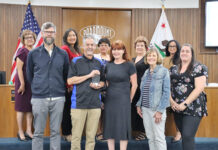Editor’s note: The following is a selection from the recent South Coast Air Quality Management District report on the agency’s air quality efforts in Paramount since October 2016. The AQMD reports that the “AQMD has made significant improvements since October 2016.” Due to space limitations, the report has been edited to remove sidebars and charts.
The South Coast Air Quality Management District has undertaken unprecedented, extensive efforts to identify and reduce sources of hexavalent chromium in the City of Paramount.This report summarizes the significant progress made and provides highlights of monitoring,enforcement, rule development, public outreach, and coordination efforts.
Introduction
This report summarizes the significant efforts and progress made since October 2016 in reducing levels of hexavalent chromium detected in outdoor air in Paramount. It includes a brief background on what led to this effort and highlights some of the key work
and results.The South Coast Air Quality Management District (SCAQMD) website has more detailed information on air sampling, multiple data reports and assessments, compliance efforts, meetings and events, and additional resources.
Efforts in 2016 and 2017 stemmed from work that started in 2013 when the SCAQMD began sampling the air around facilities in Paramount after receiving complaints about metallic odors. Data showed elevated levels of nickel and hexavalent chromium across from Carlton Forge Works.The facility voluntarily made some changes that reduced its emissions of nickel and other metals— however, hexavalent chromium levels did not decrease. In 2016, an unprecedented, much more intensive effort began that involvedextensive monitoring, working with many different agencies, and ensuring the community was involved and informed throughout.The approach was to focus on achieving results, in a collaborative and transparent fashion.
Hexavalent chromium can cause cancer over years-to-decades of exposure. It can come from metal plating, forging, and heat treating operations as well as other industrial operations. SCAQMD has rules that cover these businesses, but we have discovered previously unknown sources of hexavalent chromium that need to be assessed, and if necessary, controlled—and SCAQMD staff has proposed new rules to reduce these and other air toxics emissions.
Outreach and Collaboration
SCAQMD has one of the few labs in the U.S. that can accurately analyze community air samples for hexavalent chromium. Our staff quickly analyzes samples and makes monitoring data available on the website in a matter of days after samples are collected. In addition, audio recordings of the public conference calls and presentation materials from the public meetings are posted online.
SCAQMD has hosted five town hall meetings in the community, as well as working group and public consultation meetings for proposed rule enhancements related to metal processing, and a public meeting related to a facility covered under the AB 2588 “Air Toxics Hotspots” program.The agency also issued more than a dozen news releases during this period.
Over the last year, there have been more than 50 regularly scheduled conference calls with other government agencies such as the City of Paramount, Los Angeles County Department of Public Health, Los Angeles County Fire Department, U.S. Environmental Protection Agency, California EPA, California Air Resources Board, California Department of Toxic Substances Control, Paramount Unified School District, Los Angeles Regional Water Quality Control Board, and others.There have been 25 evening conference calls with the public (in English and Spanish), which included staff directly answering questions sent in by email, and 30 conference calls with the offices of elected representatives.
On our website (www.aqmd.gov), staff have published 3 reports on community monitoring for hexavalent chromium and multi-metals, 3 reports on the data from school monitoring, and information on how “3-sample averages” are determined for the Orders for Abatement. SCAQMD has collaborated with the state Office of Environmental Health Hazard Assessment and the Los Angeles County Department of Public Health on fact sheets related to the Paramount hexavalent chromium investigations.
Monitoring
Through an innovative use of portable air samplers, filter samples are collected and then analyzed in SCAQMD’s state-of-the-art laboratory.The chemical analysis at the low concentrations seen in community air samples (trace amounts measured in nanograms, or billionths of a gram) can only be done by a few laboratories in the nation. Monitoring has occurred at 38 community locations and 10 schools where sample equipment was provided by the California Air Resources Board. Samplers are currently in place at 23 sites, as well as 3 schools. Over 2,700 samples have been analyzed for hexavalent chromium. Another tool, placed at the parking lot of Promise Hospital, is a multi-metals monitor that identifies and measures the levels of 21 metals in close to real time (one hour).This has provided useful information on hourly and day-of-week patterns for several metals.
SCAQMD staff also collected and analyzed 148 samples of dust or loose debris collected from 18 facilities and tested emissions from 17 pieces of equipment at 6 facilities.This work has helped to identify the types of operations, and some specific facilities that have contributed to high levels of hexavalent chromium in the air.
Inspections and Enforcement Actions
SCAQMD and other agencies have done joint inspections at approximately 194 potential metal handling/processing facilities. SCAQMD has also done many additional unannounced door-to- door inspections. Inspections identified a variety of compliance and permitting issues (the majority not related to hexavalent chromium). Over 3 dozen Notices of Violation (NOVs) have been issued to 8 facilities and approximately 94 Notices to Comply (NCs) were issued to 60 facilities, resulting in changes to operations and additional facilities coming under SCAQMD permits.
Inspections, air monitoring and equipment testing, and evaluation of wind data helped identify facilities with high hexavalent chromium emissions. SCAQMD filed petitions against some facilities thorough our independent Hearing Board. After hearing all sides at public hearings (which are also webcast), the Hearing Board weighs the evidence and reaches a decision. Orders for Abatement were issued, and all facilities agreed to the terms of the orders: Aerocraft (December 2016), Anaplex (January 2017), and Lubeco (August 2017). Some companies were required to add control equipment and some had to reduce operations if air samples were above certain levels. As of November 2017, Aerocraft and Anaplex have each had to curtail their chromium-related processes four times and each partial shutdown lasted about a week. SCAQMD staff continue to work with these facilities to reduce their emissions even further.
Since October 2016, the SCAQMD has responded to approximately 900 air quality complaints in the Paramount community; the majority were odor complaints alleging Carlton Forge Works as the source. Carlton Forge Works is also under an Order for Abatement (July 2017) to reduce odors. Air quality inspectors are in the area on a regular basis to respond to complaints and do odor surveillance.The number of odor complaints has fallen and the facility has made changes to reduce odors from their operation, and is continuing to make more improvements to further reduce odors.
SCAQMD also continues to conduct regular, unannounced inspections, surveillance and complaint investigations, and follows up with facilities that have been issued NOVs or NCs to ensure compliance.
In addition, SCAQMD sponsored successful legislation, AB 1132, which starting in 2018 gives air pollution control officers the authority to issue an interim Order for Abatement to immediately protect public health or welfare from “imminent and substantial endangerment.”
Facility Improvements
Changes at facilities have included compliance and enforcement responses, voluntary actions by companies, and new rule requirements. Additional requirements are anticipated for facilities across the Basin (through future rule changes) and for specific companies (Anaplex, Aerocraft, and potentially Carlton Forge Works) which are implementing risk reduction plans for air toxics, required under SCAQMD Rule 1402.)
Anaplex added new controls for hexavalent chromium and other toxics from process tanks and a spray booth. Aerocraft added temporary portable control devices venting 2 buildings that have furnaces used for heat treating metal parts. Carlton Forge Works improved air pollution controls in their grinding room to reduce odors on an immediate basis, and is on schedule to add additional controls by January 2018.
The following rule changes apply to facilities throughout the SCAQMD’s jurisdiction: Rule 1430, adopted in March, reduces emissions from grinding at metal forging facilities. Rule 1469 scheduled for amendment in 2018, proposes new requirements for certain process tanks found at chrome plating and anodizing facilities, and further reduces emissions from these operations.















